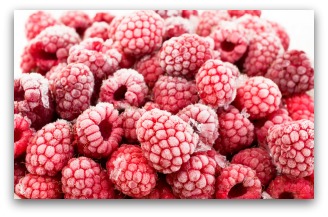Freezing Vegetables,
Berries, and Fruits
From Your Garden
Here are some great tips and "how to's" for freezing vegetables, berries, and fruits from your backyard vegetable garden!
Learn the best way to prepare, blanch and freeze garden vegetables, berries, and fruit for winter use.
Design Your Own Vegetable Garden Layout Using our Free "Vegetable Garden Planner" Software!
By freezing your home vegetables, you can enjoy almost all the fresh produce grown from your vegetable garden long after the harvesting season is over.
A friend of mine recently told me about opening up a package of corn for dinner that was frozen ten years ago, and it tasted as sweet as the day it was packed.
Nutrition, flavor, and natural color are kept better in most foods by freezing than any other preservation methods.
Most vegetables and fruits suitable for canning are suited for freezing as well.
Preparing vegetables and fruits for the freezer is quick and simple.
Food can be frozen in quantities easily that would be too small to justify the time and effort it would take to put them up by canning.
Putting up a pint or two at a time by freezing extra garden vegetables is perfectly feasible when canning such a small quantity would be uneconomical.
Freezing Vegetables Successfully
For successful freezing of garden vegetables, it is a good idea to purchase a stand-alone freezer, and not try to use the freezer compartment of your refrigerator.
The freezer should be capable of maintaining a temperature of zero degrees or below for effective initial freezing and safe storage.
Download Free Garden Planning Worksheets, Garden Diary, Zone Chart, Or Planting Guide
The colder, the better, as the freezer life of frozen vegetables kept at zero degrees or below is from 8 to 12 months.
The freezer life is much shorter if the temperature inside the freezer is only a few degrees higher.
Using air-tight containers, or heavy-duty freezer bags will also extend the freezer life of your vegetables.
How to Freeze Vegetables
- For freezing vegetables, no special equipment is necessary beyond a free-standing upright or chest-style freezer.
- You need a large pot that will hold 2 gallons or more of water for blanching or scalding the food. It's convenient to have a pot with a perforated basket insert.
- You will also need a large bowl or container for cooling the food in cold water after blanching.
- Large block of ice to speed the cooling process are helpful.
- Fill clean empty gallon or half-gallon containers with water, and freeze them several days before you begin preparing vegetables for freezing.
- A colander will be needed for draining the cooled vegetables.
Tips for Preparing Vegetables, Berries, and Fruit for Freezing
- Vegetables, berries, and fruit for freezing should be garden fresh and at the perfect stage for table use.
- Soft spots, discolored, or blemished areas should be removed.
- Do not freeze overripe vegetables or fruit.
- Thoroughly wash vegetables.
- Carefully and gently wash and dry berries or fruit.
- Prepare the food as for canning or cooking for the table, trimming or paring as necessary.
How to Blanch Vegetables Before Freezing
Nearly all vegetables must be blanched for best results before being frozen.
The simplest method of blanching vegetables is to place one pound of prepared vegetables in your perforated pot insert and immerse them in a large kettle holding at least 2 gallons of rapidly boiling water.
Cover the pot and blanch the vegetables at the recommended time for the type of vegetable you are blanching.
As soon as the blanching time is complete, remove the vegetables from the pot and cool them immediately in a large container of ice water.
Hold the vegetables in the cold water for the same length of time that they were scalded, until they are chilled.
Drain thoroughly.
If you will be blanching and freezing large quantities of vegetables, it is best to purchase a large unit made especially for this purpose.
Or use a large kettle for boiling water, and a large colander for immersing the vegetables.
Freeze Berries on Baking Sheets Before Packing in Bags
If you want to be able to remove individual servings of berries or vegetables from freezer bags without having to thaw the whole bag, here is a great tip:
Freeze the washed and dried berries or vegetables in a single layer on a cookie baking sheet.
This takes about one hour.
This method helps the fruits or vegetables to freeze quickly, without sticking to each other.
After the berries or veggies are quick-frozen, pour them into the freezer bag, label them, and return them to the freezer.
Packing Vegetables for Freezing
- Pack vegetables without delay.
- Include no liquid and be sure to
allow the correct head-space for the kind of food, allowing for
expansion.
- Foods such as broccoli, cauliflower, and asparagus need no additional headroom.
- For packaging, most people use plastic freezer bags when freezing vegetables.
- You can also use plastic freezer containers with tight-fitting lids.
- Pint and quart size containers are the most common sizes used.
Label Packages with
Date and Contents
Using a felt tip marker, label the containers and freezer bags by writing down the contents of each and the date the food was packed and frozen.
The key to freezing vegetables successfully is using high quality foods to begin with, following proper processing guidelines, ensuring all air is excluded from the containers or bags, and that they are properly sealed.
You Might Also like to Read:






